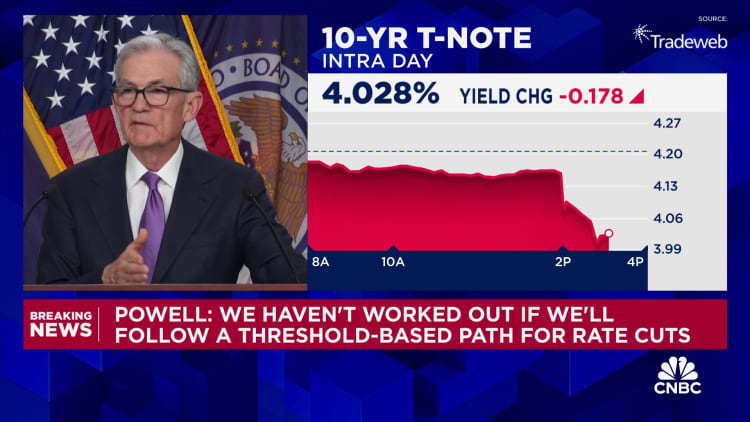Federal Reserve Chair Jerome Powell speaks during a press conference following a closed two-day meeting of the Federal Open Market Committee on interest rate policy at the Federal Reserve in Washington, D.C., on Dec. 13, 2023.
Kevin Lamarque | Reuters
Fed Chair Jerome Powell said Wednesday that the unique economic conditions created by the Covid-19 pandemic have helped the central bank’s effort to bring down inflation without causing a recession, a rare feat in economic history.
The Federal Reserve signaled in its latest economic projections that it will cut interest rates in 2024 even with the economy still growing, which would potentially be a path to the “soft landing” that many economists viewed skeptically when the central bank began aggressively hiking rates last year to fight post-pandemic inflation.
“This inflation was not the classic demand overload, pot-boiling over kind of inflation that we think about. It was a combination of very strong demand, without question, and unusual supply-side restrictions, both on the goods side but also on the labor side, because we had a [labor force] participation shock,” Powell said at a press conference after the Fed’s last meeting of the year.

The Fed has viewed its inflation fight as a two-front battle of trying to weaken the demand in the economy while the “vertical” supply curve normalized, Powell said. The supply side of various parts of the economy is now getting closer to where it was pre-pandemic, he said.
“Something like that has happened, happened so far. The question is once that part of it runs out — and we think it has a ways to run… — at some point, you will run out of supply side help and then it gets down to demand, and it gets harder. That’s very possible, but to say with certainty that the last mile is going to be different, I’d be reluctant to say we have any certainty around that,” Powell said.
“So far, so good, although we kind of assume it will get harder from here,” he added.
The description of the economy is similar to how Powell and other Fed members described the inflation situation in 2021, sometimes saying that the rapid price increases would prove to be “transitory.” The central bankers dropped that language as inflation accelerated and then began aggressively hiking rates in March 2022. The Fed has hiked its benchmark rate more than 5 percentage points in total since then.
Powell has maintained over the past year and a half that it was still possible, though not necessarily likely, that the U.S. economy could achieve a “soft landing,” where inflation returned to the Fed’s 2% target without causing a significant rise in unemployment.
Though rate hikes to slow inflation are often associated with recessions, the U.S. economy has sometimes expanded during such cycles before, most notably in the mid-1990s.
While many economists and Wall Street forecasters entered the year projecting a recession in 2023, the U.S. economy has instead proven surprisingly resilient. The stock market has also rallied after a deep sell-off in 2022, with the Dow Jones Industrial Average closing at a record high on Wednesday.
Although Powell said the U.S. economy has “slowed substantially” in recent months, the Fed still projects GDP to grow 1.4% next year.
Don’t miss these stories from CNBC PRO:
Credit: Source link














